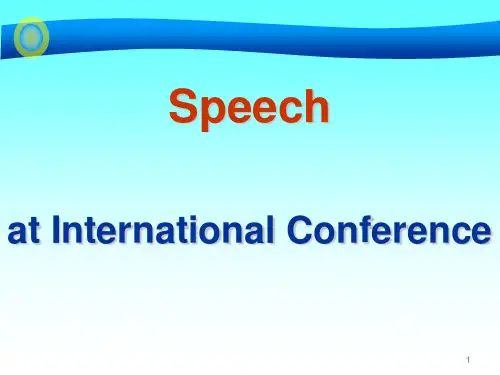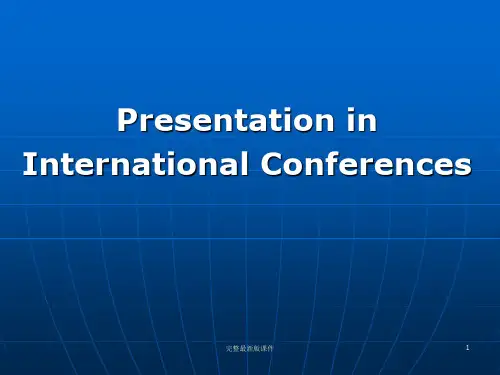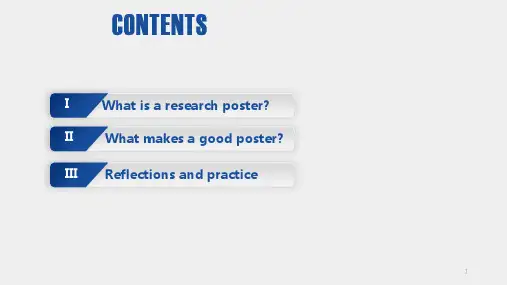英语国际会议PPT
- 格式:pptx
- 大小:13.19 MB
- 文档页数:21
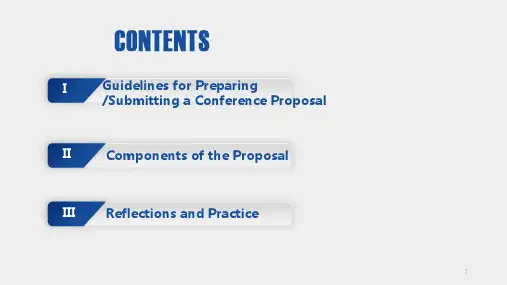
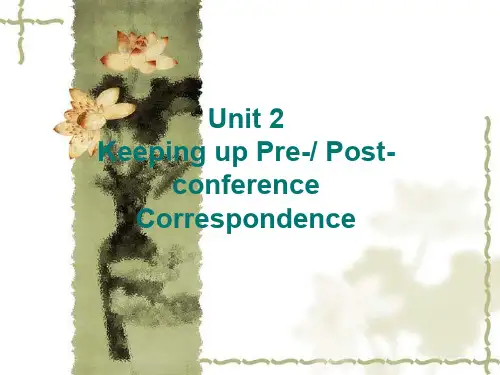

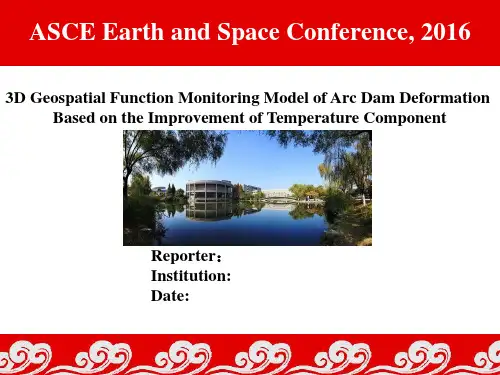
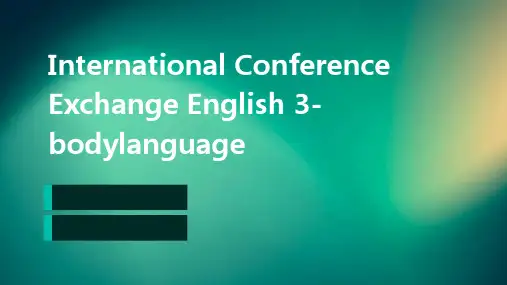
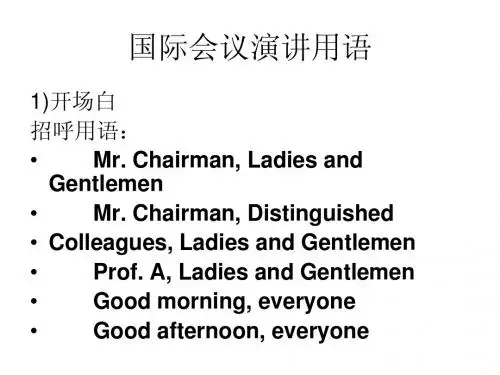
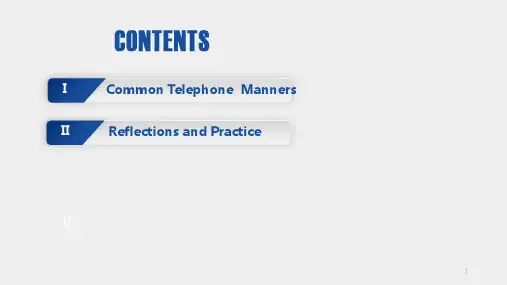

国际会议英语概论戴世强(上海市应用数学和力学研究所)1.国际学术会议ppt稿的准备:◆篇幅:ppt文件的页数~演讲分钟数;◆字数:每页一般不超过30个词;◆字体:一般不小于32号;◆内容:尽可能用图表,少用公式;◆文字:杜绝语法、拼写错误;◆附录:10页之内,在回答问题时用;◆禁忌:蝇头小字;通篇公式。
2.演讲的组成部分:1)开场白——打招呼,自我介绍,客套;2)引言——缘起,思路,方法;3)论述——理论或实验过程描述;4)分析——陈述、剖析结果;5)结论——总结性叙述;6)示谢——感谢听众。
3.国际会议演讲用语1)开场白招呼用语:◆Mr. Chairman, Ladies and Gentlemen◆Mr. Chairman, distinguished colleagues, Ladies and Gentlemen◆Prof. A, Ladies and Gentlemen◆Good morning, everyone◆Good afternoon, everyone感谢主席或自我介绍:◆Thank you very much, Professor ***, for your kind introduction.◆Thank you, Mr. Chairman, for your gracious introduction.◆My name is ***, from ***. The title of my presentation is ***.◆I am *** from ***. The topic of my paper is (about) ***.社交辞令:◆I am delighted [honored, privileged, proud, happy, …] to be here (with you thismorning).◆I am honored to have the chance to address you on this special occasion.◆It’s a great pleasure for me to be here.◆I appreciate the opportunity to be here to attend this mini-symposium [session].勾画轮廓(显示提纲、目录):◆I am g oing to give this talk in four parts. First…, Second…, Third…, Finally…◆The outline of my talk is as follows.◆My presentation will be divided into the following three parts.◆I would like to divide my talk into three parts: 1)background of …; 2) recent resu ltsin my group; 3)conclusions.2)引言点明主题:◆My discussion today on *** will try to summarize its complex nature and to presentsome of our new findings.◆My point this morning will be to illustrate …◆My purpose today is to make a general comment on recent progress in study of …and to give some new results on...◆My topic today will deal with one of the most serious problems we are facing…◆The paper I’m going to present today will describe some of the important aspects inthis area.◆It is my intention this afternoon to summarize some recent a dvances in … andwhat’s going on at …[in…].2)引言阐释背景:◆The motivation of this work is like this.◆*** has found its wide application in various fields of science and technology.◆I think it would be best to start out by making some general comments on previouswork in this area.◆I would like to preface my remarks with a brief description of advances in…说明思路:◆The basic idea in our work can be elucidated as follows.◆Based on previous work, we developed a new technique [method, algorithm,experimental device, numerical model…] in [for]…◆To obtain meaningful results, we constructed [established, put forward] a physical[mathematical] model with…◆To give the analytical [numerical] results, we make the following assumptions[hypotheses] and use the methods [theorems] of…◆The main procedure of experiments [co mputations, derivation, deduction…] couldbe described as follows.简介结果:◆With the above-mentioned methods, we have the following new findings.◆Simulated results shows a fairly good agreement with experimental data.◆The numerical results verified the effectiveness of the presented model.3)论述展开论述:◆Now I will give the mathematical formulation of the studied problem.◆The sketch of the configuration is like this.◆The governing equations [boundary conditions, initial conditions,…] are…◆I’d like to give a brief description of the mathematical model we established.◆Now I will give a simple introduction to the experimental set-up.◆The system consists of three parts…◆Experiments were conducted at XXX.◆The main procedure of experiments is as follows.◆We have paid special attention to data processing…详细描述:◆Let me make two remarks in detail. First of all, I’d like to describe the experimental[theoretical, numerical…] methods. The second remark is its application to the studied problem.◆I’d like to go into some detail on this question.◆Let us consider some of these factors in more detail.◆We will discuss this matter in a little detail as we go on.◆Since this problem is very important to us. I’d like to spend some time describing itin greater detail.◆I’d like to discuss this issue at length.◆I’d like to address myself to the most important aspects of the treatment…简略描述:◆In the interest of time, [In the interest of brevity, For the sake of time, Because ofthe time limitation,…] I won’t go into details on this subject [I won’t enter into details on this topic].◆I don’t feel that I should spend too much time giving the detail of…◆I’d like to offer s short description of…◆I’d just like to go through these various issues rapidly.◆Due to the limitation of the schedule, I will consider these interesting points verybriefly.◆Let’s go over these points very quickly.◆Let me touch on this topic briefly.◆There is one more issue I’d like to touch upon.4)分析结果陈述(借助于图表、公式):◆Through the above analysis [simulation, experiment], we have the following results[findings].◆We show the simulation [numerical, theoretical, experimental] results in thefigures…[ lists…].◆We give the comparison between numerical and experimental results in Figure 1.◆The relation between A and B is presented here.◆With these figures, we exhibit the dependence of A on B.◆From this figure we can clearly see the effects of A on B.◆From the above deduction, we have the main theorem in this study.结果分析:◆From these figures, we can see that the obtained numerical results agree well with[are in good agreement with, accords with, are consistent with ]the experimental data.◆From these curves, we can conclude [reach the conclusion] that with increasing A, Bdecreases.◆From this figure we find some discrepancies between theory and experiments, whichmight come from…◆With these results, we witness the crucial role played by multiple scales.◆We have confirmed the tendency of the variation of A observed in previousexperiments.5)结论结论陈述:◆I would like to conclude with a few of remarks on this problem.◆Allow me to conclude by listing the following points.◆Let me conclude by making an observation concerning…◆In conclusion, I would like to indicate the following points.◆I would like to close by saying that…◆In closing, I would like to comment on the application of this theory.◆I would like to close my speech by a few words.◆Now, I’d like to sum up the results of this investigation.◆To summarize my talk, the presented model is realistic and effective in use.展望未来:◆Finally, I must say a few words about the perspective of the studied issue.◆XXX is still an open problem.◆The problem on XXX is needed to be solved in future study.◆The method presented here could be generalized to the case…6)示谢感谢听众:◆Thank you for your attention [endurance, patience,…].◆I want to thank you for your attention [endurance, patience,…].◆Once again I would like to thank you for the opportunity of talking to you on thesubject.回答问题积极的回答:◆ A good question. I’d be delighted to answer.◆I’d like to respond to that question briefly.◆Let me first reply rapidly to the first question.◆May I answer your second question first?◆In answer the second question, I would say that it is a good idea.◆The simplest answer to your question would be that we concluded based on theexperimental observations.◆Let me try to answer these questions one by one.◆I think I can answer this question simply.消极的回答:◆I (really, am afraid, just) don’t know.◆I’m sorry, but I don’t know.◆I don’t know exactly yet.◆I don’t know how to do that [enough about that, of any such studies].◆I don’t know about the availability of this matrial.◆I know very little about it.◆I’m not sure.◆I’m not sure of the answer [I can answer the ques tion, whether it is necessary, Iunderstand what you mean].◆I’m afraid I cannot answer your question.◆I’m afraid I cannot give you a precise answer.◆I can’t answer your question accurately right now.关于证据:◆I do have some evidence to support the mechanism. …◆I have sufficient data on this point.◆I can give you some quantitative evidence to explain this.◆I don’t have any data available to answer your question.◆I have no idea about it.。
